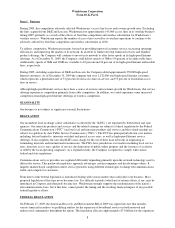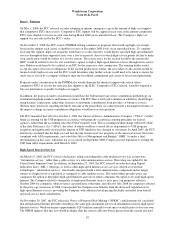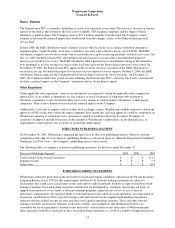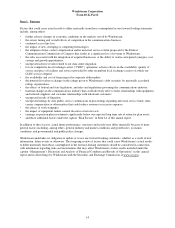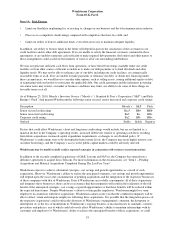Windstream 2009 Annual Report Download - page 84
Download and view the complete annual report
Please find page 84 of the 2009 Windstream annual report below. You can navigate through the pages in the report by either clicking on the pages listed below, or by using the keyword search tool below to find specific information within the annual report.
Windstream Corporation
Form 10-K, Part I
Item 1. Business
by competitive local exchange carriers. If the NPRM’s tentative conclusion is adopted, Windstream would likely see a
reduction in the amounts that it pays to rent space on utility poles it does not own and would be able to better compete
with other companies offering high-speed Internet services.
As part of the American Recovery and Reinvestment Act (“ARRA”), Congress directed the FCC to report to Congress
by mid-February 2010 with a National Broadband Plan. As part of the Plan, it is expected that the FCC will consider a
myriad of issues related to high-speed Internet access deployment and adoption and, among other things, may consider
universal service and intercarrier compensation reform. On December 7, 2009, Windstream, CenturyTel, Inc.
(“CenturyLink”) , Frontier Communications Corporation, Consolidated Communications Holding, Inc. and Iowa
Telecom filed a plan with the FCC to reform the intercarrier compensation and universal service mechanisms and
further deploy broadband in unserved areas. If adopted, the proposal would stabilize intercarrier compensation and
universal support and provide additional funds to Windstream to assist with the deployment of broadband services to
rural areas.
Communications Assistance for Law Enforcement Act
In 1994, Congress enacted the Communications Assistance for Law Enforcement Act (“CALEA”) to preserve the
ability of law enforcement officials to conduct electronic surveillance effectively and efficiently in the face of rapid
advances in telecommunications technology. The FCC has adopted rules that implement the requirements set forth in
CALEA. Under CALEA, the Company is required to provide law enforcement officials with call content and call
identifying information upon receipt of a valid electronic surveillance warrant. The Company is compliant in all
material respects with all CALEA requirements.
Customer Proprietary Network Information
Customer Proprietary Network Information (“CPNI”) includes information such as the phone numbers dialed,
frequency of calls, duration of calls and retail services purchased by a customer. The Telecommunications Act of 1996
requires service providers to ensure the confidentiality of CPNI and provides that CPNI may be used, disclosed or
shared only if required by law, the customer has given consent, or CPNI is necessary for the provision of services from
which CPNI was derived. The FCC has implemented rules that require service providers to establish safeguards to
prevent the unauthorized disclosure of CPNI.
On April 2, 2007, the FCC released an order and further notice of proposed rulemaking to alter the requirements to
safeguard customers’ CPNI. The order prohibits carriers from disclosing call detail information based on customer-
initiated telephone contact except when the customer provides a password or, if the customer does not provide a
password, the carrier may only disclose the requested call detail records by sending them to the customer’s address of
record. The order further requires carriers to obtain explicit consent from customers when releasing CPNI to third
parties for the purposes of marketing retail services to that customer. The order also establishes a notification process
for law enforcement and customers in the event of a CPNI breach, requires that carriers provide notice to customers
immediately following certain account changes and requires carriers to file annual certifications of CPNI compliance
with the FCC. Some parties have filed petitions for reconsideration with the FCC asserting that, in enforcement
proceedings, the order improperly shifts the burden of proof from the FCC to the carriers. These rules became effective
during the fourth quarter of 2007.
Other Federal Regulations
On September 6, 2008, the FCC released an NPRM tentatively concluding that the agency should require all facilities-
based providers of broadband and/or telecommunications to collect and produce infrastructure, service quality, and
customer satisfaction data that previously were required only from a subset of ILECs. Expanding the data collection as
proposed could require Windstream to devote new resources to gathering data and producing reports. But without more
specificity regarding the likely outcome of the proceeding, we cannot provide an estimate of the financial impact of a
change in our data collection and reporting obligations.
On July 26, 2007, the Company received an inquiry from the FCC’s Enforcement Bureau questioning certain details
surrounding the Company’s compliance with FCC reporting requirements related to network outages. On May 12,
2009, the Company entered into a consent decree with the FCC that resolved all outstanding issues on this matter.
11









